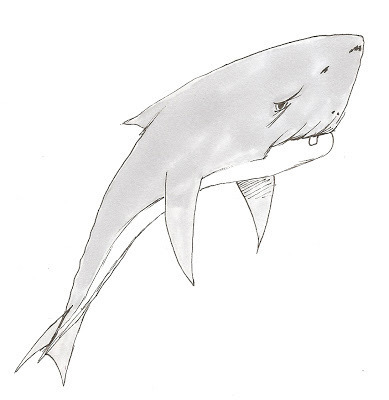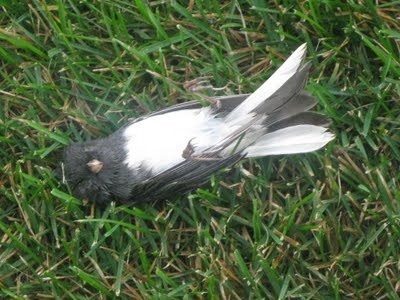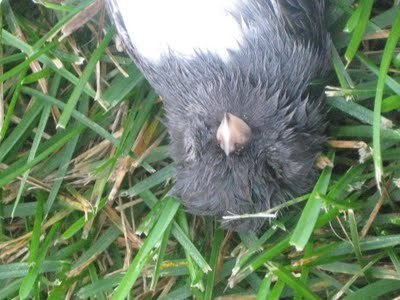Gordon Grice's Blog, page 30
August 9, 2013
Put Some Meat in Your Shark Week

While the world is watching bogus documentaries with eternal commercial breaks on TV this week, may I suggest some factual material for your reading pleasure?
In Shark Attacks, I collaborated with National Geographic's team of scientists and editors to tell of sharks eating people--and vice versa. You'll read about these topics:
The Red Sea shark attacks of 2010.
A man swallowed whole by a great white.
The species most likely to remove your hands.
How humans inadvertently draw sharks to shore.
How a shark attack turned one woman against soup.
How sharks support the huge human population of this planet.
. . . and lots more.


And if you're still hungry after that, may I suggest The Book of Deadly Animals, available in paper or ebook form. Its shark chapter covers these topics:
The Jersey Shore attacks of 1916.
Motives for great white attacks, plus some of the most brutal cases.
Sharks in war, including the tragedy of the USS Indianapolis.
A record dive attended by oceanic whitetip sharks.
Jaws and our cultural reactions to sharks.
. . . and lots more.
That's just the shark chapter, mind you; this book surveys the mightiest killers in the animal kingdom in text and photos.


Illustration: Ugly Shark Week by Beckett Grice

Published on August 09, 2013 19:14
August 8, 2013
Python Behavior--On Killing Two Children at Once

Credit: MangoAtchar/Creative Commons
Further thoughts about the tragic case in New Brunswick, in
which a rock python apparently killed two sleeping children in the same room.
In a thoughtful comment on Monday’s post, James raised this question:
A final point which leads me to
think that, even if nothing sinister is going on, somebody is not being
truthful is the way things supposedly went down. For all the guff and hype
about snakes being "silent predators"--although I have not fed live
rodents for years now, I can testify that mice, rats and hamsters, even when
grabbed by snakes larger in relation to them than this python was to the
children, do not die instantly or silently. The animal typically kicks and
thrashes, and usually has time to squeal once or twice. Obviously, as the Jesse
Altom case shows, exceptions occur, but the odds of a snake pulling off
back-to-back killings without causing some sort of commotion seem very long to
me.
My response: There are precedents for this. In a 2011 paper
in PNAS, Headland and Greene report a case from the Philippines in which a
reticulated python entered a hut where three children were sleeping. It killed
two boys, aged 3 and 4, and was in the act of swallowing one of them when the
father discovered the attack and killed the python with a knife. The snake had
not harmed the other sibling, an infant girl. The same paper reproduces an x-ray
image of a reticulated python which has swallowed two long-tailed macaques.
These cases show that pythons can sometimes succeed in
killing several primates in sequence. In another interesting case, a retic
killed a dog and then attacked a 22-month-old child, who was rescued by his
father. (Incidentally, there are also cases of big constrictors swallowing
juvenile monkeys along with their mothers.)
Young children typically sleep far more soundly than adults
do, an ability to that gradually wears off as the child matures. That may help explain how the second victim
was able to stay asleep while the first was killed. It’s also plausible that,
even if the second victim heard some sort of noise, he might not have seen or
suspected danger.
Speculation aside, what we do know is that taking multiple
small prey items at a time is definitely python behavior. We know that, in at
least one other case, a python has killed two children in the same room. And we
know that, in the case of Jesse Lee Altom, a python killed a child without
rousing either of the two adults sleeping next to him.

Published on August 08, 2013 00:28
August 5, 2013
Python Kills Two Children
In Campbellton, New Brunswick, a pet snake escaped, then apparently crawled through the ventilation system and into a living room. There it killed two children--Noah Barthe, 5, and his brother Connor, 7. An RCMP spokesperson said they were "strangled," but probably the mode of death was asphyxiation by constriction. That, at least, has been the cause of death in other cases of large constrictors killing humans. Such incidents are rare; the victims are almost always either the owners of pet snakes or their children. Though the snake involved here was kept in a pet store, it was actually the private pet of the owner. He was the best friend of the children's father, and the children were sleeping over with his son at his apartment above the store. After discovering the children's bodies, the owner found and captured the snake. He turned it over to police. His own son was sleeping in a different room and was not harmed.
The motive in such attacks appears to be predation but, as in this case, the snake does not actually consume the victim. As mentioned in The Book of Deadly Animals, the snake will examine its killed prey carefully before consuming it. It is at this point that the snake apparently finds something about humans unpalatable. Tales of predation on humans in the wild are common but polluted with folklore, though a couple of scientific publications in recent years support the idea that reticulate pythons may prey on humans.
This snake was an African rock python weighing 45 kilograms (99 pounds) and measuring between 3.5 and 4.5 meters (roughly 11 and a half to fifteen feet). A much smaller member of this species killed three-year-old Jesse Lee Altom in Centralia, Illinois, in 1999, as he slept between two adults.
Related Post: Rock Python Trapped in Fence
Thanks to D'Arcy for the news tip.

The motive in such attacks appears to be predation but, as in this case, the snake does not actually consume the victim. As mentioned in The Book of Deadly Animals, the snake will examine its killed prey carefully before consuming it. It is at this point that the snake apparently finds something about humans unpalatable. Tales of predation on humans in the wild are common but polluted with folklore, though a couple of scientific publications in recent years support the idea that reticulate pythons may prey on humans.
This snake was an African rock python weighing 45 kilograms (99 pounds) and measuring between 3.5 and 4.5 meters (roughly 11 and a half to fifteen feet). A much smaller member of this species killed three-year-old Jesse Lee Altom in Centralia, Illinois, in 1999, as he slept between two adults.
Related Post: Rock Python Trapped in Fence
Thanks to D'Arcy for the news tip.

Published on August 05, 2013 21:06
August 1, 2013
Pollinating
Published on August 01, 2013 05:00
July 29, 2013
Underground with the Beetles

To cope with the grind, I reward myself with nature walks.
Five minutes will do. By parking in a certain lot on my way to teach a class, I
can take in a creek-bank where gray squirrels go skittering. They are audible
in the fallen leaves of autumn, and sometimes I can even hear their claws as
they race up the trunks of oaks. Once I saw a squirrel miss its leap and go
tumbling down the steep bank. (It did better the second time.) Another parking
lot allows me to pass by oaks with interesting gnarls in their trunks. One of
them has an old and long-overgrown wound wide as a fireplace. It looks like a
face. The snarling lips are thick crenellations of bark; The bared teeth are a
weather-white slab of wood. I even perceive, among the rough bark above,
demented eyes.

But I found myself at a disadvantage the other day.
Construction and busloads of visitors barred me from the parking lots amid the
green. I corkscrewed into a parking garage where machine sounds, boxed and
amplified, replaced the sounds of birds and leaves. Worse: I had to go
underground. A cold bluish buzz replaced the sun. My boots bounced flat echoes
from the cement.
Suddenly I saw that my path would, within fifteen or 20 feet,
cross that of another creature.

It was tiny, but for an insect, large; I could identify it
from a distance as a beetle. I was incredulous, though,
because familiar traits I never expected to see again clarified themselves as I
approached. The size, first of all. Since moving to the north, I’ve seen plenty
of beetles, but nothing thumb-sized like I used to see in Oklahoma. Second,
its massive mandibles seemed to travel in a private cloud. It reminded me of the
ones I used to see lassoed shut by black widow spiders.

So we met. The beetle stopped, aware of my shadow or, more
likely, my tread. It glistened as brightly, even in the dim fluorescence, as my
old Oklahoma friends; but in place of their black, this one was reddish brown.
The cloud around its head was indeed spider web, though of a flimsier make than
the widow’s. Possibly the beetle had run
through a disused web; if the spider had been home, it certainly hadn’t been
sturdy enough to stop this guest. The beetle looked as if it might resume its
advance. I breathed on it. It reared and spread its mandibles to threaten me.
I have rarely felt so welcome. The beetle didn’t want me,
but somehow I’d come home.
A car approached. The beetle was in the way of traffic, but
I stood over it protectively. It remained in its threat posture even as I
protected it, its mandibles raised like the tusks of a sniffing pig.

I needed something to put it in. In Oklahoma, I was rarely
at a loss for a vessel, because paper cups and plastic bottles were always
lying around. Saint Paul, Minnesota, does not reliably offer such amenities. It
must be cultural. I would have to improvise. In my book bag I found a tiny
bottle of ibuprofen. I emptied it, the pink pills trickling out to mingle with
the dimes and nickels in the bottom of my bag. The vial’s mouth was just large
enough to accommodate the beetle’s body, but the beetle objected. It grasped
the mouth with its hooked feet and refused to enter. Next I found an envelope
in which I carried papers that must have once seemed important. I prodded; the
beetle opened its mandibles wider; I paused while another car drove around me.
It parked nearby. I wondered how I would explain myself, but the driver strode
by me at a businesslike clip, her ringed thumb punching text keys.

When I’d finally succeeded with my prodding, the beetle
seemed content in the envelope.
Photography by D'Arcy Allison-Teasley

Published on July 29, 2013 04:30
July 24, 2013
Study of a Dead Bird



Photography by Parker Grice
No animals were harmed in the making of this post. We just found it that way.

Published on July 24, 2013 03:00
July 17, 2013
Wildlife Classics: Rhinoceros

by JH Patterson
Rhinos are extraordinary animals, and not in any way to be depended upon. One day they will sheer off on meeting a human being and make no attempt to attack; the next day, for no apparent reason, they may execute a most determined charge. I was told for a fact by an official who had been long in the country that on one occasion while a gang of twenty-one slaves, chained neck to neck as was the custom, was being smuggled down to the coast and was proceeding in Indian file along a narrow path, a rhinoceros suddenly charged out at right angles to them, impaled the centre man on its horns and broke the necks of the remainder of the party by the suddenness of his rush. These huge beasts have a very keen sense of smell, but equally indifferent eyesight, and it is said that if a hunter will only stand perfectly still on meeting a rhino, it will pass him by without attempting to molest him. I feel bound to add, however, that I have so far failed to come across anybody who has actually tried the experiment. On the other hand, I have met one or two men who have been tossed on the horns of these animals, and they described it as a very painful proceeding. It generally means being a cripple for life, if one even succeeds in escaping death. Mr. B. Eastwood, the chief accountant of the Uganda Railway, once gave me a graphic description of his marvellous escape from an infuriated rhino. He was on leave at the time on a hunting expedition in the neighbourhood of Lake Baringo, about eighty miles north of the railway from Nakuru, and had shot and apparently killed a rhino. On walking up to it, however, the brute rose to its feet and literally fell on him, breaking four ribs and his right arm. Not content with this, it then stuck its horn through his thigh and tossed him over its back, repeating this operation once or twice. Finally, it lumbered off, leaving poor Eastwood helpless and fainting in the long grass where he had fallen. He was alone at the time, and it was not for some hours that he was found by his porters, who were only attracted to the spot by the numbers of vultures hovering about, waiting in their ghoulish manner for life to be extinct before beginning their meal. How he managed to live for the eight days after this which elapsed before a doctor could be got to him I cannot imagine; but in the end he fortunately made a good recovery, the only sign of his terrible experience being the absence of his right arm, which had to be amputated.

Published on July 17, 2013 03:00
July 10, 2013
Video: Hornets vs. Bees
An awesome predatory raid. If you can look past the melodramatic filmmaking, the photography is really impressive.


Published on July 10, 2013 03:00
July 3, 2013
Wildlife Classics: Murdering Some Rodents

Reinhard Kraasch/Creative Commons
Woodchucks
A Wildlife Classic by Maxine Kumin
Gassing the woodchucks didn't
turn out right.
The knockout bomb from the Feed and Grain Exchange
was featured as merciful, quick at the bone
and the case we had against them was airtight,
both exits shoehorned shut with puddingstone,
but they had a sub-sub-basement out of range.
Next morning they turned up again, no worse
for the cyanide than we for our cigarettes
and state-store Scotch, all of us up to scratch.
They brought down the marigolds as a matter of course
and then took over the vegetable patch
nipping the broccoli shoots, beheading the carrots.
The food from our mouths, I said, righteously thrilling
to the feel of the .22, the bullets' neat noses.
I, a lapsed pacifist fallen from grace
puffed with Darwinian pieties for killing,
now drew a bead on the little woodchuck's face.
He died down in the everbearing roses.
Ten minutes later I dropped the mother.
She
flipflopped in the air and fell, her needle teeth
still hooked in a leaf of early Swiss chard.
Another baby next. O one-two-three
the murderer inside me rose up hard,
the hawkeye killer came on stage forthwith.
There's one chuck left. Old wily fellow, he keeps
me cocked and ready day after day after day.
All night I hunt his humped-up form. I
dream
I sight along the barrel in my sleep.
If only they'd all consented to die unseen
gassed underground the quiet Nazi way.

Published on July 03, 2013 02:21
June 27, 2013
Striped Hyena Kills Teen

From Kenya, the story of a 15-year-old killed by a hyena. The striped species of hyena occasionally preys on children in Africa and Asia. (The spotted hyena is larger and more prone to kill people.) This attack, however, suggests rabies. It happened in daylight, and the hyena refused to give up even when outnumbered and wounded. Hyenas, like cats and some canines, go violently mad with rabies.
Classmate pays tribute to brave Class Five pupil killed by hyena | The Star:
"His flowing tale of the unfortunate attack that sent his soul mate to an early grave left everybody, including stone-hearted warriors and local politicians, with rolling tears on their faces. Lenana told the mourners how Marapush behaved after they saw the beast charging at them. 'Marapush told me to hold his book and sweater so that he could handle the hyena with his bare hands. He told me that if he dies, I should take the book and the sweater to his parents.'"
Thanks to Hodari Nundu for the news tip.

Published on June 27, 2013 03:00








